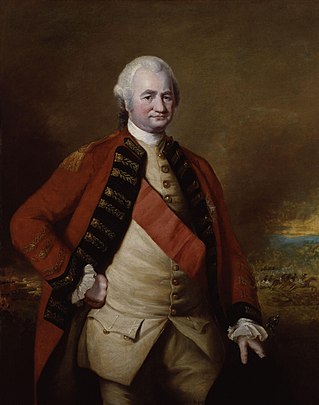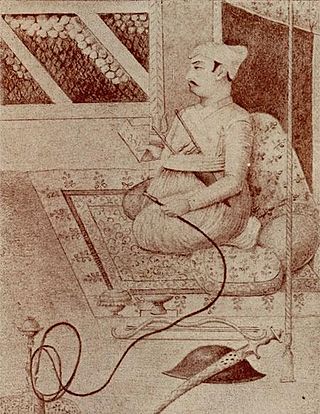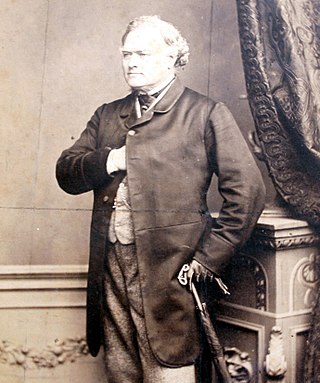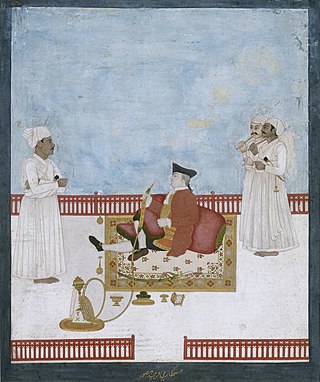Related Research Articles

Warren Hastings was a British colonial administrator, who served as the first Governor of the Presidency of Fort William (Bengal), the head of the Supreme Council of Bengal, and so the first Governor-General of Bengal in 1772–1785. He and Robert Clive are credited with laying the foundation of the British Empire in India. He was an energetic organizer and reformer. In 1779–1784 he led forces of the East India Company against a coalition of native states and the French. In the end, the well-organized British side held its own, while France lost influence in India. In 1787, he was accused of corruption and impeached, but he was eventually acquitted in 1795 after a long trial. He was made a Privy Councillor in 1814.

Robert Clive, 1st Baron Clive,, also known as Clive of India, was the first British Governor of the Bengal Presidency. Clive has been widely credited for laying the foundation of the British East India Company (EIC) rule in Bengal. He began as a writer for the EIC in 1744 and established Company rule in Bengal by winning the Battle of Plassey in 1757. In return for supporting the Nawab Mir Jafar as ruler of Bengal, Clive was guaranteed a jagir of £30,000 per year which was the rent the EIC would otherwise pay to the Nawab for their tax-farming concession. When Clive left India in January 1767 he had a fortune of £180,000 which he remitted through the Dutch East India Company.

Mirza Muhammad Siraj-ud-Daulah, commonly known as Siraj-ud-Daulah or Siraj ud-Daula, was the last independent Nawab of Bengal. The end of his reign marked the start of the rule of the East India Company over Bengal and later almost all of the Indian subcontinent.

William Benedict Hamilton-Dalrymple is an India-based Scottish historian and art historian, as well as a curator, broadcaster and critic. He is also one of the co-founders and co-directors of the world's largest writers' festival, the annual Jaipur Literature Festival. He is currently a Visiting Fellow at All Souls College, Oxford.

Shuja-ud-Daula was the Subedar and Nawab of Oudh and the Vizier of Delhi from 5 October 1754 to 26 January 1775.

Shah Alam II, also known by his birth name Ali Gohar, or Ali Gauhar, was the seventeenth Mughal emperor and the son of Alamgir II. Shah Alam II became the emperor of a crumbling Mughal Empire. His power was so depleted during his reign that it led to a saying in the Persian language, Sultanat-e-Shah Alam, Az Dilli ta Palam, meaning, 'The empire of Shah Alam is from Delhi to Palam', Palam being a suburb of Delhi.

The Nawab of Bengal was the hereditary ruler of Bengal Subah in Mughal India. In the early 18th-century, the Nawab of Bengal was the de facto independent ruler of the three regions of Bengal, Bihar and Orissa which constitute the modern-day sovereign country of Bangladesh and the Indian states of West Bengal, Bihar and Odisha. The Bengal Subah reached its peak during the reign of Nawab Shuja-ud-Din Muhammad Khan. They are often referred to as the Nawab of Bengal, Bihar and Orissa. The Nawabs were based in Murshidabad which was centrally located within Bengal, Bihar, and Odisha. Their chief, a former prime minister, became the first Nawab. The Nawabs continued to issue coins in the name of the Mughal Emperor, but for all practical purposes, the Nawabs governed as independent monarchs. Bengal continued to contribute the largest share of funds to the imperial treasury in Delhi. The Nawabs, backed by bankers such as the Jagat Seth, became the financial backbone of the Mughal court.

Mir Syed Jafar Ali Khan Bahadur was a commander-in-chief or military general who reigned as the first dependent Nawab of Bengal of the British East India Company. His reign has been considered by many historians as the start of the expansion of British control of the Indian subcontinent in Indian history and a key step in the eventual British domination of vast areas of pre-partition India.

Mir Qasim was the Nawab of Bengal from 1760 to 1763. He was installed as Nawab with the support of the British East India Company, replacing Mir Jafar, his father-in-law, who had himself been supported earlier by the East India Company after his role in winning the Battle of Plassey for the British. However, Mir Jafar eventually ran into disputes with the East India Company and attempted to form an alliance with the Dutch East India Company instead. The British eventually defeated the Dutch at Chinsura and overthrew Mir Jafar, replacing him with Mir Qasim. Qasim too later fell out with the British and fought against them at Buxar. His defeat has been suggested as a key reason in the British becoming the dominant power in large parts of North and East India.

Alivardi Khan was the fourth Nawab of Bengal from 1740 to 1756. He toppled the Nasiri dynasty of Nawabs by defeating Sarfaraz Khan in 1740 and assumed power himself.

The Indian Medical Service (IMS) was a military medical service in British India, which also had some civilian functions. It served during the two World Wars, and remained in existence until the independence of India in 1947. Many of its officers, who were both British and Indian, served in civilian hospitals.
Roger Drake was a British administrator in the East India Company. He served as President of Fort William in Bengal between 1752 and 1756 and was later reprimanded for his actions during the Siege of Calcutta in 1756.

Feroze Jung III or Nizam Shahabuddin Muhammad Feroz Khan Siddiqi Bayafandi also known by his sobriquet Imad-ul-Mulk, was the grand vizier of the Mughal Empire when it was under Maratha suzerainty, making them the de facto rulers.
Thomas Adams, was a British Army major, posthumously promoted to Brigadier-general based on accounts of his defence of the British position in Bengal in 1763.

Lutfunnisa Begum was the 3rd wife and primary consort of Siraj ud-Daulah, the last independent Nawab of Bengal.

Sir John Spencer Login was a Scottish surgeon in British India, best remembered as the guardian of Maharajah Duleep Singh and the Koh-i-Noor diamond following the annexation of Punjab and Last Treaty of Lahore.
The Bengal War, also called campaign for the eastern Subahs, was waged by the Mughal imperial crown Prince Ali Gauhar so as to recapture Bengal from the British East India Company (EIC). Hostilities began in 1756 and ended in 1765.

William Fullerton was a Scottish surgeon who served the East India Company in Bengal and Bihar from 1744 to 1766. He is best known for his close ties with local people, their languages and for surviving the 1763 attack by the order of Nawab Mir Qasim of Bengal, against the British.
Ghulam Hussain Khan also known as Ghulam Husain Khan Tabatabai (1727/28-1797/98) was an 18th century Indian historian and scholar-administrator from Delhi who later settled in Azimabad (Patna). He is the writer of the famous book Seir Mutaqherin, one of the notable contemporary historical accounts on the late Mughal Empire.

Jagat Seth was a wealthy merchant, banker and money lender family from Murshidabad in Bengal during the time of the Nawabs of Bengal.
References
- ↑ Dalrymple, W. (2019). The Anarchy. London: Bloomsbury. pp. 185–6.
- ↑ Dalrymple, W. (2019). The Anarchy. London: Bloomsbury. p. 184.
- ↑ Brown, Rebecca M. (2006). "Inscribing Colonial Monumentality: A Case Study of the 1763 Patna Massacre Memorial" . The Journal of Asian Studies . 65 (1): 91–113. doi:10.1017/S0021911806000076. ISSN 0021-9118. JSTOR 25075973. S2CID 154678773.
- O`malley, L. S. S. (1924). Bihar And Orissa District Gazetteers Patna. Concept Publishing Company. ISBN 9788172681210.
- Crawford, Lieutenant-Colonel D. G. (1930). Roll of the Indian Medical Service 1615-1930. Vol. 1. Andrews UK Limited. ISBN 9781781502297. - ↑ Sinha, K. K. (1995). "Dr William Fullerton and the Patna Massacre of 1763" (PDF). Proceedings of the Royal College of Physicians of Edinburgh. 25 (2). Royal College of Physicians of Edinburgh: 292–3. PMID 11639641 . Retrieved 25 October 2020.
- ↑ Dalrymple, W. (2019). The Anarchy. London: Bloomsbury. p. 186.